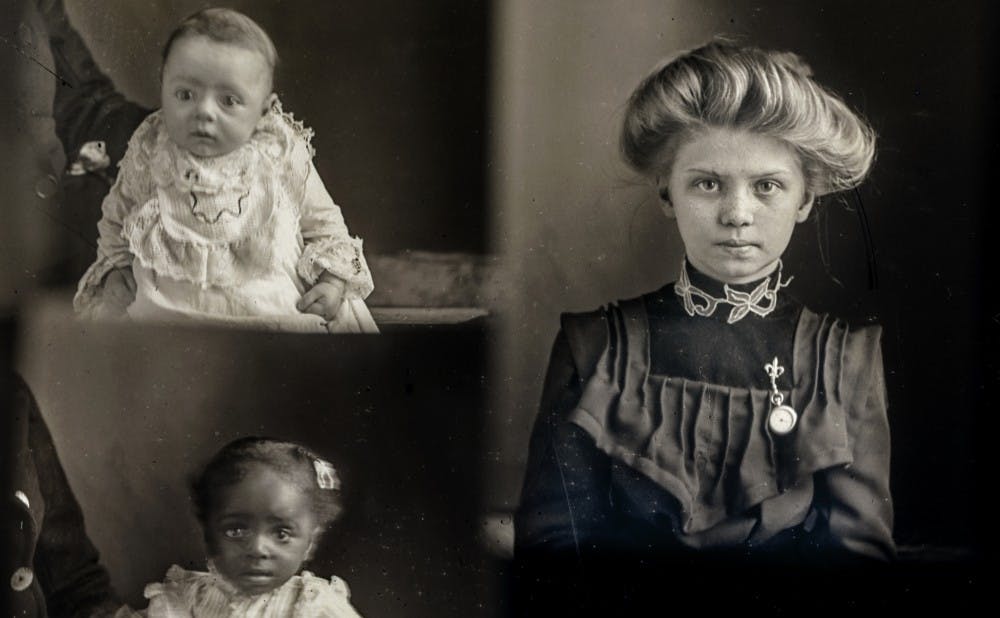With the rapid spread of images through avenues like social media, it can be easy to take photography for granted today. Yet at the turn of the 20th century, this new medium of art was just coming into existence — and how it would be manipulated and utilized remained unclear.
The Nasher exhibit, “Where We Find Ourselves” captures the tumultuous time period during which Hugh Mangum photographed the South, a time overlayed with the question of racial segregation and gender discrimination. The title stresses what curators and editors Margaret Sartor and Alex Harris believe to be unique about Mangum’s photography: different people with different backgrounds all coming together in a single photo studio.
“Everyone understood that [Mangum] thought they were special, that their story was one he wanted to tell,” Harris said.
Hugh Mangum was born in 1877, the last year of Reconstruction, in the newly incorporated city of Durham, North Carolina. Despite his family’s business background, Mangum was enthralled with the art world from a young age. At 12 years old, he attended the Methodist Female Seminary, studying in their art department. He then moved to explore the arts further at Salem College, an all-women’s university founded with a belief in education for all regardless of race or gender.
Even after his extensive artistic training in traditional mediums like paint and pastel, as soon as Mangum got his hands on a camera, he was infatuated.
From 1899 to 1922, Mangum traveled throughout North Carolina and southwestern Virginia, working out of temporary spaces and making affordable pictures as a commercial photographer. He would follow circuses and Vaudeville shows around, all while offering his services to a variety of people, from those born into slavery — like the grandmother of Civil Rights activist Pauli Murray — to Washington Duke himself.
The late 19th century, the high point of Mangum’s career, was shaped by the beginning of Jim Crow, and for most businesses, this separation of races was law. Regardless, Mangum’s photographs revealed a different side of the South, with many races, classes and genders sharing a single negative and even a waiting room.
As Sartor expressed, rather than focusing on race or gender, what mattered for the subjects of Mangum’s photographs was “how would you perform in front of the camera, yourself, your personality.”
Perhaps it was his own unique “outsider status” within his family or his distinctly liberal educational background or even his life in Durham, as a city with no pre-Civil War history, that instilled Mangum’s progressive belief system as a photographer. As both Harris and Sartor stated, whatever it was created the foundation for unique personal galleries and intimate gifts.
For five decades, his photographs remained untouched, degrading in the Mangum family barn. Their survival depended on the work of community members who believed they were valuable, collecting them in boxes and storing them away in their homes. When Sartor and Harris first accessed the photos, the damage had covered some of the faces of Southern predecessors and historic figures.
“[The damage] is a layer of meaning that coincides with our history,” Sartor said.
Mangum’s photographs depict a unique blend of lives, both shaped by labor and filled with prosperity. These moments Mangum would display were empowering, simply rare depictions of laughter, joy and human life. And his impermanent studio allowed for a unique expression of these individuals, one without the traditional props other photographers utilized. It was about the relationship between two individuals, separated by a camera.
“Mangum simply stripped it down so that the picture became whatever the person brought to it,” Sartor said.
Although Harris and Sartor have worked on a number of projects together, this project meant introducing a previously unheard-of voice into the art world.
“It was an opportunity to work together and make sense of this body of work in our way,” Harris said.
They scoured through at least 10,000 negatives, searching for those that struck them. After narrowing this seemingly endless pool of photos, the duo began to edit, enlarge and personalize Mangum’s body of work.
“It was special to respond to each picture on its own. We got to create this body of work out of Mangum’s, something so personal to us,” Harris said.
Ultimately, what Mangum provides is a window into the history of this country. Today, in a time when most of the world takes photography for granted, a reminder of the past is essential.
“You can read a history book, but it is a whole ‘nother thing to look into the faces of the farmers and circus performers and families and just everyday people," Sartor said.
"Where We Find Ourselves" will be on display in the incubator gallery at the Nasher from Jan. 19 to May 19.
Get The Chronicle straight to your inbox
Signup for our weekly newsletter. Cancel at any time.

